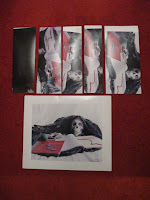Object Project
'Redundancy'
My project is about redundancy: Using objects to symbolise or visually represent redundancy in a still life.
'Redundancy'
My project is about redundancy: Using objects to symbolise or visually represent redundancy in a still life.
My initial work was developed and presented at interim review, this included research and the completed image; Issues were highlighted and I decided to go back to the start and reviewed my approach. I wasn't happy with the image I'd produced, and it was clear the references I’d used (Vanitas) were inappropriate. The image was too obtuse and overcomplicated with tenuous links to the references.
My initial sketch from October had two options, so I decided to try the alternate, changing the image and the references.
I had to start over again looking for visual references and realised that it was something I'd probably find more easily from a media source, rather than an Art source (due to the subject matter). All my original research work remains on my blog (for my first image), and is available to view as such. With my new image concept I searched newspapers before finding the images online (associated to publicised newspaper articles), from this I noted the source (Getty Imageshttp://www.gettyimages.co.uk/Search/Search.aspx?contractUrl=2&language=en-GB&family=creative&p=redundancy&assetType=image) and reviewed the 'Stock images' they had. Once assured the objects were already accepted visual symbols for redundancy, I set about planning an image. This time, less abstract and more simple, with a desk, background, and lighting that I felt represented an office space, since this was essentially a still life image (unlike the Getty images).
My initial sketch from October had two options, so I decided to try the alternate, changing the image and the references.
 |
| Initial Image (rejected after interim review) |
 |
| Original concept with two alternate versions (boxed-bagged) |
I had to start over again looking for visual references and realised that it was something I'd probably find more easily from a media source, rather than an Art source (due to the subject matter). All my original research work remains on my blog (for my first image), and is available to view as such. With my new image concept I searched newspapers before finding the images online (associated to publicised newspaper articles), from this I noted the source (Getty Imageshttp://www.gettyimages.co.uk/Search/Search.aspx?contractUrl=2&language=en-GB&family=creative&p=redundancy&assetType=image) and reviewed the 'Stock images' they had. Once assured the objects were already accepted visual symbols for redundancy, I set about planning an image. This time, less abstract and more simple, with a desk, background, and lighting that I felt represented an office space, since this was essentially a still life image (unlike the Getty images).
 |
| Image care of (Getty Images via) http://www.guardian.co.uk/money/blog/2011/jan/31/dear-jeremy-have-your-say (Image by Steve Cole http://www.stevecole.com via http://www.gettyimages.co.uk) 30th Nov 2010 |
 |
| Image care of http://www.gettyimages.co.uk |
Final shoot contacts:
 |
| Contacts (brown desk) |
 |
| Contact (green desk) |
 |
| Prints (both brown and green desk options) |
Body Project
'The Salvation Army'
My project consists of; The Salvation Army: Members of the Salvation Army in portrait, a study of modern day faith
Wanting both a local (to Medway) and community based sitter(s) that were unknown to me, I set about meeting both aspects of the brief via one group or organisation. Knowing people in the Dartford Salvation Army, I set about getting contact details for the Medway church and visited the Chatham corps to seek sitters. After a face to face meeting with Andria Still (Salvation Army Chatham) I had three sitters on offer, and with continued contact I was able to shoot all three. I found two books (Pillars of the Church and Picturing Faith) on religious portraiture with images ranging from the 1920's into the 1980's. I also contacted the Salvation Army and received several of their publications for review to see how they were portrayed as an organisation.
Wanting both a local (to Medway) and community based sitter(s) that were unknown to me, I set about meeting both aspects of the brief via one group or organisation. Knowing people in the Dartford Salvation Army, I set about getting contact details for the Medway church and visited the Chatham corps to seek sitters. After a face to face meeting with Andria Still (Salvation Army Chatham) I had three sitters on offer, and with continued contact I was able to shoot all three. I found two books (Pillars of the Church and Picturing Faith) on religious portraiture with images ranging from the 1920's into the 1980's. I also contacted the Salvation Army and received several of their publications for review to see how they were portrayed as an organisation.
I shied away from classical art as visual references again since the Salvation Army has always been quite a modern (established in 1865) and forward thinking organisation, especially when compared with other churches. I wanted the poses be in keeping with the ethos of the organisation to which they belonged. I'd already decided to go for a stark Richard Avedon inspired white background, as I wanted the images to focus on the subjects without distractions. Brian Griffin used the same visual style on occasion.
 |
| Brian Griffin Images from Brian Griffin's St Pancras series (images via http://www.briangriffin.co.uk) |
 |
| Richard Avedon Lee Friedlander by Richard Avedon http://www.richardavedon.com |
 |
| Press Image DailyMail |









No comments:
Post a Comment